
It’s been a while since my last post hasn’t it folks? Well thanks for sticking with me. After over a year, I have a new recipe for you: Lincolnshire Chine.
Why has it taken such a long time to hunt this one down? Well, the cut of meat required to make this regional speciality is only available in Lincolnshire, and even then, it is pretty tricky to find. It’s also a long way from Manchester!

Jane Grigson explains the special cut needed: ‘It is across the back of the neck, across the backbone, a section of which is included.’ Hence the name chine. The resulting piece of meat which is square in shape is then dry-cured.
I researched the chine and discovered so many other Lincolnshire specialities that I thought I should make a podcast episode about it. I was lucky to talk to chef Rachel Green about chine and Lincolnshire food in general. She also managed to get me a square piece of chine from one of her suppliers: Woldsway Meat and Game.
Listen to the podcast episode here:
Today the original chine cut is no longer used, instead, a square cut taken from the side of the spine is taken. The meat is then cut with deep slashes, stuffed with parsley, wrapped up and poached. After cooling it is sliced to reveal stripes of meat and parsley. Rachel said there should be no other ingredients, however, Jane includes several more in hers: marjoram, leeks, onions, and even optional lettuce and raspberry leaves. Rachel had never heard of any of these ingredients being added to the stuffing of a chine. Later, I found an article Jane wrote in the Guardian way back in 1984 where she said that, indeed, today just chopped parsley is used. Her additions come from a very curious source: the 19th century French poet Paul Verlaine who ‘in the mid-1870s, spent a year as a schoolmaster just north of Boston [Lincolnshire]. He like chine so much that he tried to find it elsewhere in England but without success.’ It was his description that Jane used as the basis of her recipe, and it is he who described the unusual ingredients listed above.
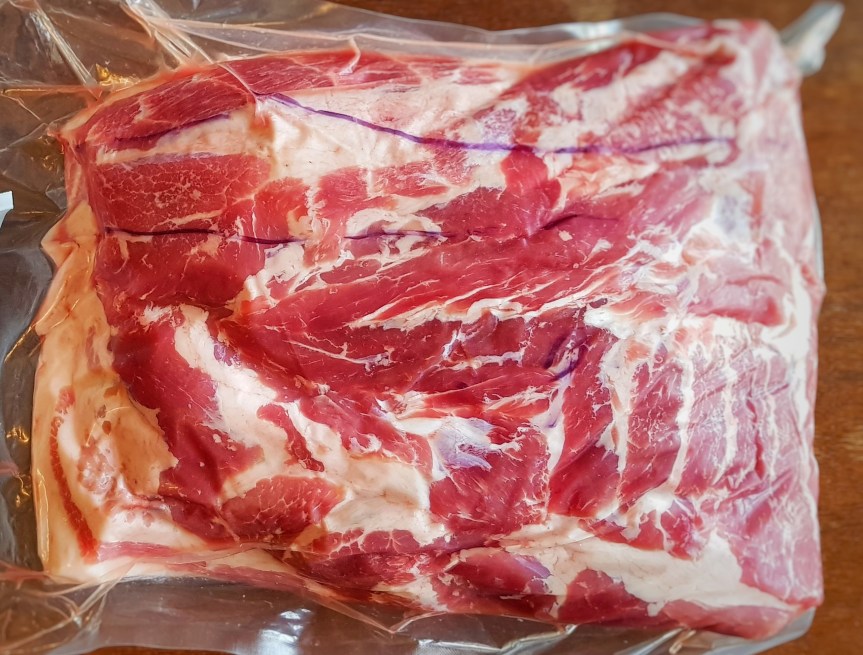
As it would turn out, weighing in at 6 kilos, the chine Rachel gave me was far too big for any cooking vessel in my house, so I had to divide it in two, freezing one half for a future stuffed chine. As it would turn out, a 3-kilo piece of chine, is what Jane calls for in her recipe.
With the meaty side facing up, I cut deep slashes going to within a centimetre of the skin about 1½ centimetres apart in the direction of the grain of the muscle. If you have somehow got your hands on an old-fashioned chine cut, make cuts toward the bone, then turn over and repeat on the other side.
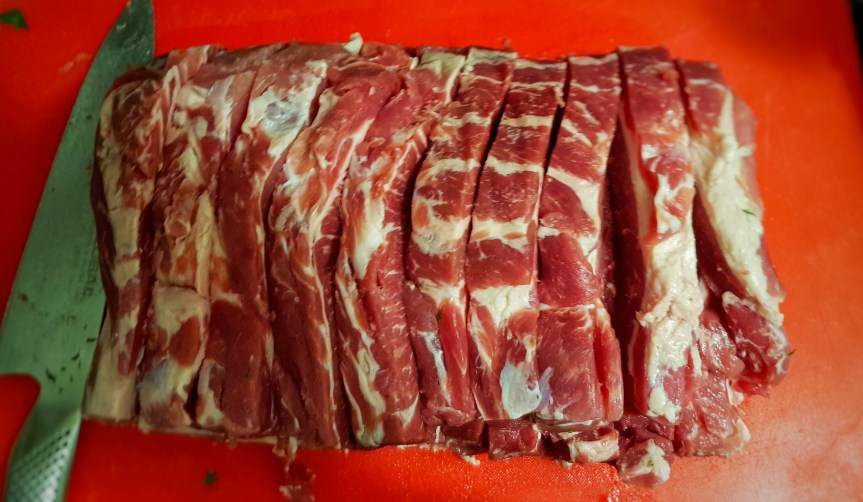
Next, I prepared the stuffing from 2 very large bunches of parsley, stalks and all, plus two, trimmed and cleaned, leeks. (Jane gives an alternative to the leeks in the form of 2 bunches of spring onions and a lettuce.) I roughly chopped the greens and put them in my food processor for chopping, along with some fresh thyme and marjoram leaves. Jane also suggested a handful of young raspberry leaves as an optional extra; it’s the wrong time of year for raspberry leaves, so I had to give those a miss. I seasoned the whole thing with ground mace and black pepper and then chopped it all finely – don’t go too far with this, they should be chopped, not made into a paste.
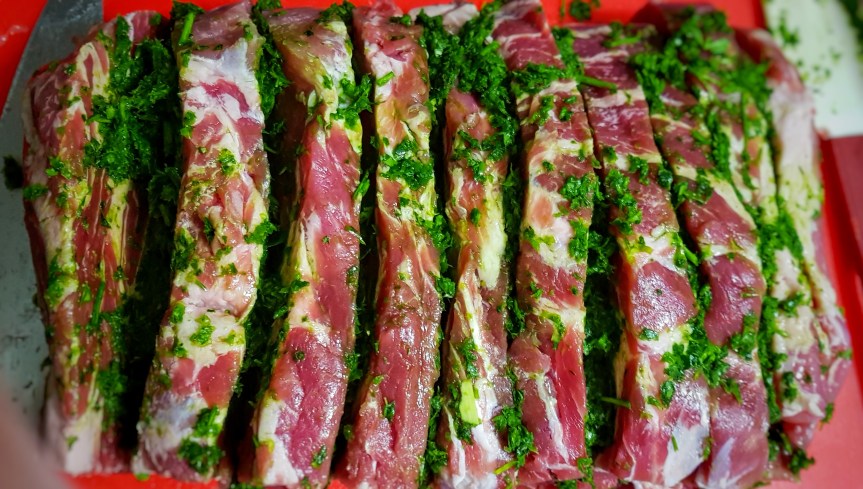
I took the stuffing and filled the slashes as deeply and evenly as I could – it was quite a satisfying job actually, sort of meditative. Next, I wrapped the meat tightly in a double layer of muslin and tied it into place with butcher’s twine.
It now needed to be poached, but it was still too big for any of my pots, so instead I popped it into a large roasting tin, poured over hot water and sealed it with foil before gingerly sliding it into my oven set to 160°C. Whether you go by this method or simply bring it to a simmer in a stock pot, it should take 3 hours cooking.
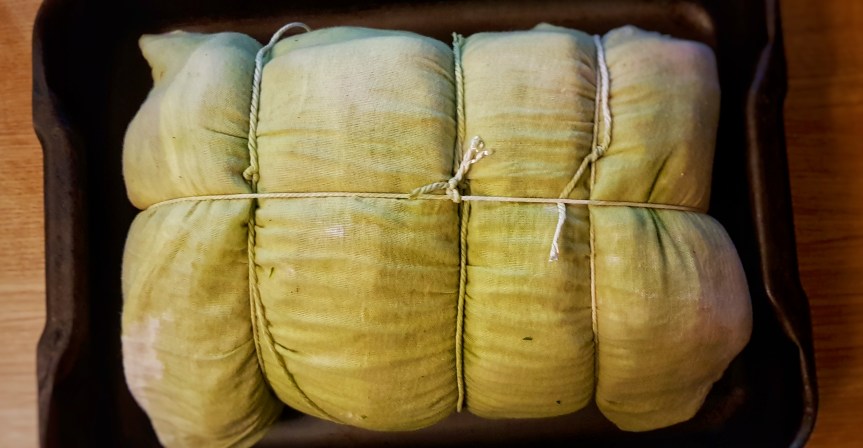
When it’s ready, remove from the water and sit it on a chopping board or large plate, place another board on top and then a weight (I used my heavy-based food processor) so that the meat sets: it makes the meat firm, easier to cut, and it removes any air bubbles, lengthening its shelf-life. Cool overnight; my kitchen is cold, so I left it out overnight, but if you’d rather, do this in the fridge.
Next day, unwrap the meat and slice it as thinly as possible. I was very impressed with the look of it I must say: pale pink flesh and deep green stripes. Very effective.
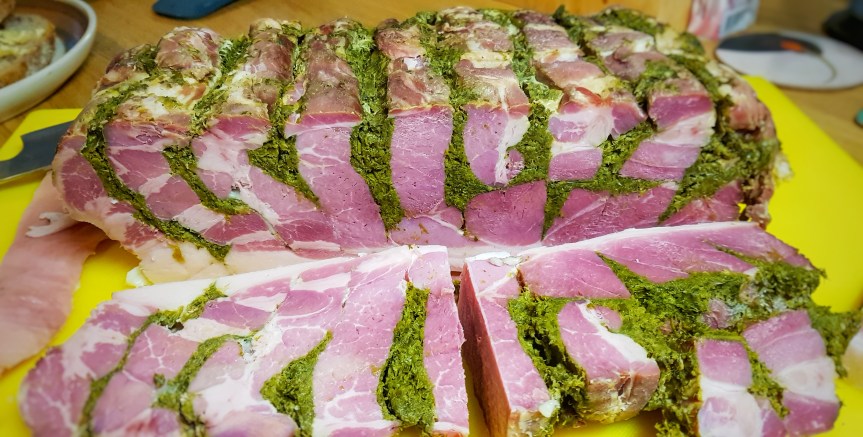
Jane suggests eating the chine with a vinaigrette, bread and butter, and salad. I also tried it sprinkled with a vinegar and sugar dressing (approximately a 2:1 ratio) as suggested by Rachel.
#446 Lincolnshire Chine. After all this effort and after being told it was an acquired taste, I was worried I wouldn’t like the chine, but it was really good. The meat was tender and salty-sweet, and the parsley intensely grassy, and aromatic from the marjoram and spices. I have to say, the sugar-vinegar dressing elevated it from a good dish to a very good one. If you can get hold of a chine, have a go at making it. I shall certainly be making it again. Score: 7/10.
If you like the blogs and podcast I produce and would to start a £3 monthly subscription, or would like to treat me to virtual coffee or pint: follow this link for more information. Thank you.

Reblogged this on British Food: A History and commented:
A blog post on my other blog, Neil Cooks Grigson, where, after a good while of searching, managed to get some Lincolnshire Chine. Enjoy!
LikeLike